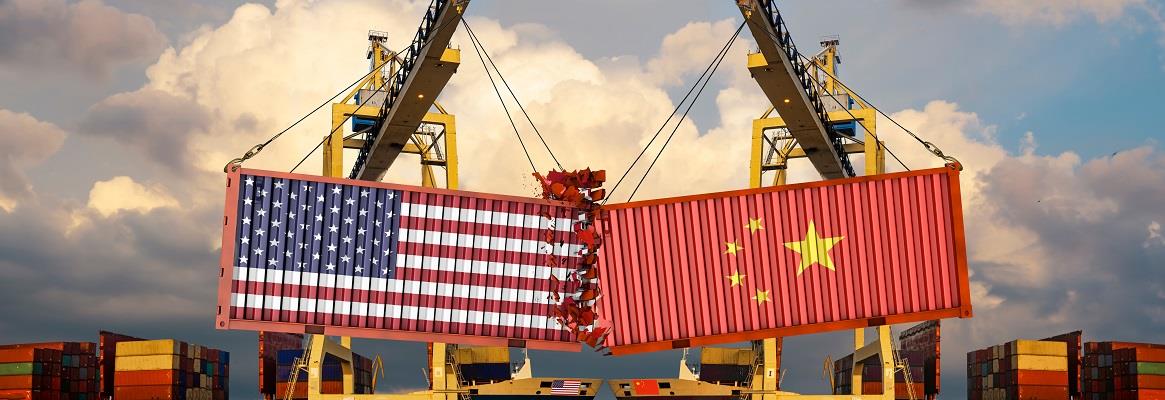Almost two years down the line, the US-China trade war continues with the newly elected US government refusing to waive off the earlier imposed tariffs on China. A report.
The Office of the US Trade Representative (USTR) had slashed imports worth $200 billion with 25 per cent tariff rate of List 3 from the previous 10 per cent rate, effective May 10, 2019.
In August 2019, the US imposed a 10 per cent tariff on Chinese imports worth $300 billion starting September 1, 2019 for certain products and from December 15, 2019 for the second group of products. USTR (Office of the United States Trade Representative) imposed 25 per cent tariffs on clothing.
After the US imposition, China's State Council Tariff Commission (SCTC) announced the retaliatory tariffs on US products of worth $75 billion in two stages.
China imposed an additional 10 per cent tariff on US products of Sections 1 and 2 of Annex I and additional 5 per cent tariff on products listed in Sections 3 and 4 of Annex I from September 1, 2019 ($19.50 million textiles and apparel products).
China imposed an additional 10 per cent tariff on the US products of Sections 1 and 2 of Annex II and additional 5 per cent tariff on goods of Sections 3 and 4 of Annex II, from December 15, 2019. But it got suspended due to US-China “Phase One” trade deal ($1363 million textiles and apparel products).
After the Chinese retaliation president Trump had declared the next plan of imposition.
As of October 1, 2019, the US increased the Section 301 tariff rate for products on Lists 1-3 to 30 per cent of worth $250 billion ($3.70 billion textile products) from the previous 25 per cent.
As of September 1, 2019, products on List 4A of worth $112 billion ($31 billion textiles apparel and home textiles) was subjected to an additional tariff of 15 per cent from 10 per cent announced earlier.
As of December 15, 2019, products on List 4B of worth $160 billion ($4.7 billion textiles, apparels, and home textiles products) were subjected to an additional tariff of 15 per cent higher compared to previous rate of 10 per cent.
There are some exclusions given below with HS codes including textiles and apparel products from US section 301 against Chinese products as of January 1, 2021 but extended till March 31, 2021.
| Exclusions with HS Codes | ||||
| 5603120090 | 5210114040 | 5504100000 | 6210105010 | 6116106500 |
| 5603149090 | 5210116020 | 6210105090 | ||
| 5603920090 | ||||
| 5603930090 | ||||
Exclusions Subjected to 25 per cent tariff after January 1, 2021.
| 54022030 | 56039200 | 5007200065 | 5108108000 | 5501200000 |
| 5407522060 | 5007200085 | 5501400000 | ||
| 5407619930 | ||||
| 5407619935 | ||||
| 5407720015 |
Exclusions subjected to 25 per cent punitive tariff after August 7, 2020.
| 55131100 | 59032025 | 58063220 | 51061000 | 54075220 | 56031200 |
| 59031020 | 5701901010 | 5810929080 | 60053900 | 54071000 | 56039410 |
| 60011020 | 5705002030 | 6001920000 | 55169200 | 54083290 | 56090030 |
| 5512190090 | 52081140 | 6003406000 | 59039020 | 54075220 | 5603949090 |
| 5514220020 | 52082140 | 55164400 | 54079220 | 56090040 |
Exclusions subjected to 7.5 per cent punitive tariff after January 1, 2021.
| 5210114040* | 6210105000* | 6208911020 | 6111305015 | 6108910030 |
| 5210116020* | 6116106500* | 6208920020 | 6207911000 | 6111206070 |
| 5504100000* | 6208911010 |
*Note: Extended Until March 31, 2021.
In January 2021, the US President, Biden announced that he would not remove tariffs imposed by the previous president Trump on China in short term. Presently Biden tries to get the previous momentum in their trade with their allies.
In 2021, initially China became ready to purchase $200 billion worth of the US goods and services through 2021. China has developed an action plan to strengthen intellectual property protection and end forced technology transfers.
The US has imposed 25 per cent tariffs on $250 billion in Chinese imports, including apparel and footwear. The US continued the Section 301 tariffs on finished apparel and textile imports from China to address intellectual property theft and other predatory trade practices by China.
The US must take some actions against the Chinese by continuing punitive tariffs on finished products along with other enforcement actions to manage government subsidies, state-owned enterprises, forced labour practices, weak environmental standards, intellectual property theft and currency manipulation. According to a white paper from Greenberg Traurig’s Government Law & Policy practice, Biden’s trade view is more focused on multilateral action to resolve trade conflicts.
The government of China planned to reduce sliding tariffs on cotton cargoes imported under additional quotas. The number of products with lower than MFN tariffs and imported under temporary import tariffs had increased from 859 to 883 from January 1, 2021. The lower sliding tariffs would reduce the cost of importing cotton fibre into China.
The US residents and businesses have received more than $72 billion in additional tariffs on products after the China 301 tariffs were put into place. It affected the money in the pockets of US residents, less speed of US manufacturing, and decreased competitiveness for American businesses.









Comments